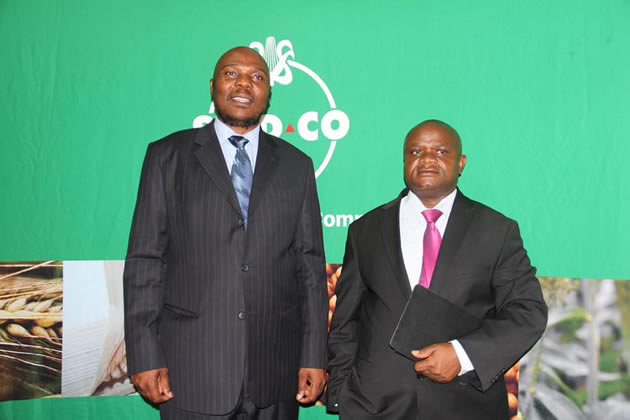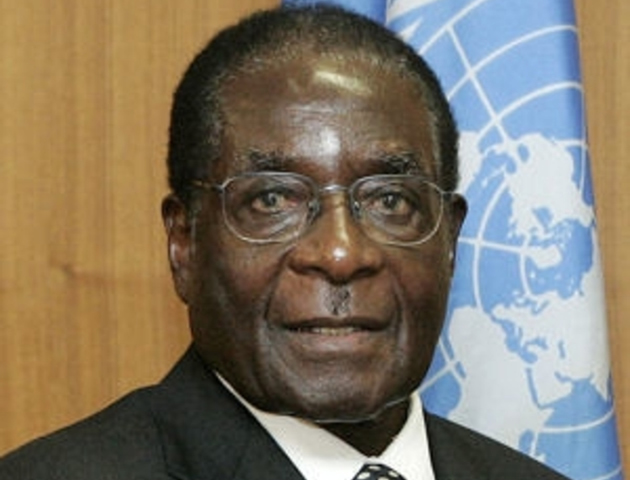Seed Co to focus on open market sales


Seed Co Limited group chief executive Morgan Nzwere and Finance Director John Matorofa at the half-year results for September analysts’ briefing last week. Seed Co reported an 11 percent increase in sales volume
Seed Co says there will be a greater emphasis of open market sales going forward after governments in Zimbabwe, Zambia and Malawi reduced input programmes for this year.
Seed Co’s model has previously been over-reliant on governments. However, due to the effects of a regional economic crisis even that would struggle and as such the group would even out the effects by growing the high margin veggie seed business as well as increase its market share in East Africa.
Chief executive Morgan Nzwere told analysts last week that major challenges for the group in the outlook come from weakening regional economies as well as erratic rainfall in the major markets the group operates in.
“The Government input programmes in Zimbabwe, Zambia and Malawi have been reduced significantly so it’s a tough season ahead.”
In Zimbabwe, Seed Co had been awarded 44 percent of the Government tender through a structured finance deal although Mr Nzwere noted that the total order of 3 000mt was half of last year’s programme.
“The Government order is down 50 percent so we are currently lobbying for Government to increase the size of the input programme.”
In Zambia, there had been pricing challenges due to the movement of the kwacha but the group was now invoicing the FISP government programme in US$ in order to protect value. The FISP programme itself was down by 39 percent. Mr Nzwere said the group was now selling soya for cash while using inter-company trade as a hedge. In Malawi turnover had been affected by the withdrawal of IRLAD Programme.
“The other problem is that the Malawi government announced its input programme in kwacha at 14,5 billion but the funding is not clear and worse still there are pricing challenges as the government is setting prices for the input scheme.”
There were positives though, Mr Nzwere said, and these included the move to get into the market earlier than is usually normal buoyed by the increasing demand of ultra-early maize seed varieties (SC301 and SC303) which mature faster. The group will also increase its market share in Kenya, Tanzania and DRC as these had shown impressive growth projectiles. In Kenya, the business had been showing steady growth but the MNLD remains a challenge with new outbreaks having been recorded. Mr Nzwere said a highlands processing facility was under construction. Tanzania volumes were up 25 percent on prior year although there was a late start to the rain season.
“Our emphasis is now on increasing market coverage and footprint in the southern highlands.”
In the CCU area, there had been an early start to the ISPAAD programme in Botswana while South Africa’s erratic rains were affecting sales. The group was still to get a major breakthrough in Ethiopia and Nigeria while payment issues were hindering the development of Rwanda.
On Research and Development, the group registered two soyabean varieties while two maize varieties were released in Uganda and the ultra-early was released in Kenya. Mr Nzwere said the joint Seed Co/Limagrain projects were progressing particularly on MNLD breeding. Mr Nzwere said the group was moving towards a ratio of 12 percent on research on turnover from the current 6 percent, in line with Limagrain policy.
The group has 50 000mt of maize seed which is available across the group and is adequate to cover anticipated demand. In terms of market sales, Mr Nzwere said all outlets were fully stocked and merchandiser activities had increased.
“The only major problem is that erratic rains have affected shelf off take and this had increased the GTI beneficiaries.”
For the half year to September 30, volume sales were up 11 percent. As is expected in the first half, the group reported a loss $5,56 million which was however an improvement from the negative $7,6 million reported last year. The bulk of the business 80 percent is played out in the second half. – Wires.
Finance director John Matorofa said that the narrowed loss was due to the fact that last year’s result included losses from the discontinued cotton seed business.
Turnover in the period amounted to $18.79 million, an increase of 17 percent on the comparable period last year. “There was an increase in volumes as we went to the market quite early in Zimbabwe, Kenya and Botswana. Maize volumes were up 23 percent to 6 124mt while there was a slight recovery in winter cereals (wheat and barley) to 2 819mt from 2 635mt, an increase of 7 percent.” The group had also seen contribution from Prime Seeds. Prime Seeds, which Nzwere said controls 50 percent of the market, had contributed 9 percent to turnover. “The aim is to grow turnover of Prime Seeds to a 10 percent contribution at year end. – Wires











Comments